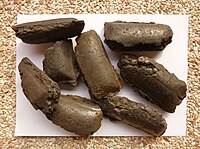
Photo from wikipedia
Metallurgical dusts can be recycled through direct reduction in rotary hearth furnaces (RHFs) via addition into carbon-based composite pellets. While iron in the dust is recycled, several heavy and alkali… Click to show full abstract
Metallurgical dusts can be recycled through direct reduction in rotary hearth furnaces (RHFs) via addition into carbon-based composite pellets. While iron in the dust is recycled, several heavy and alkali metal elements harmful for blast furnace operation, including Zn, Pb, K, and Na, can also be separated and then recycled. However, there is a lack of understanding on thermochemical behavior related to direct reduction in an industrial-scale RHF, especially removal behavior of Zn, Pb, K, and Na, leading to technical issues in industrial practice. In this work, an integrated model of the direct reduction process in an industrial-scale RHF is described. The integrated model includes three mathematical submodels and one physical model, specifically, a three-dimensional (3-D) CFD model of gas flow and heat transfer in an RHF chamber, a one-dimensional (1-D) CFD model of direct reduction inside a pellet, an energy/mass equilibrium model, and a reduction physical experiment using a Si-Mo furnace. The model is validated by comparing the simulation results with measurements in terms of furnace temperature, furnace pressure, and pellet indexes. The model is then used for describing in-furnace phenomena and pellet behavior in terms of heat transfer, direct reduction, and removal of a range of heavy and alkali metal elements under industrial-scale RHF conditions. The results show that the furnace temperature in the preheating section should be kept at a higher level in an industrial-scale RHF compared with that in a pilot-scale RHF. The removal rates of heavy and alkali metal elements inside the composite pellet are all faster than iron metallization, specifically in the order of Pb, Zn, K, and Na.
Journal Title: Metallurgical and Materials Transactions B
Year Published: 2017
Link to full text (if available)
Share on Social Media: Sign Up to like & get
recommendations!